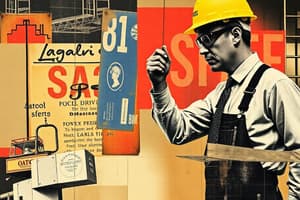Podcast
Questions and Answers
OSHA requires fall protection when exposed to a ______ fall or greater.
OSHA requires fall protection when exposed to a ______ fall or greater.
4 foot
What are common fall hazards? (Select all that apply)
What are common fall hazards? (Select all that apply)
- Floor Openings/Pits (correct)
- Wall Openings (correct)
- Overhead Platforms (correct)
- Shelving Units (correct)
- Cooling Systems
- Overhead Runways (correct)
What is the hierarchy of fall hazard control?
What is the hierarchy of fall hazard control?
Eliminate the fall hazard, prevent the fall, control the fall.
What are examples of ways to eliminate hazards?
What are examples of ways to eliminate hazards?
What is the height from the upper surface of the top rail to the floor level?
What is the height from the upper surface of the top rail to the floor level?
What is the standard toeboard clearance above the floor?
What is the standard toeboard clearance above the floor?
What are the A, B, Cs of Personal Fall Arrest Systems?
What are the A, B, Cs of Personal Fall Arrest Systems?
How does a personal fall arrest system work?
How does a personal fall arrest system work?
A personal fall arrest system (PFAS) anchorage point must be capable of handling ___ pounds.
A personal fall arrest system (PFAS) anchorage point must be capable of handling ___ pounds.
What is the biggest cause of accidents?
What is the biggest cause of accidents?
Most deaths happen between ___ feet.
Most deaths happen between ___ feet.
Match the following safety terms with their definitions:
Match the following safety terms with their definitions:
What does proper planning for fall protection include?
What does proper planning for fall protection include?
What are the parts of a scaffold?
What are the parts of a scaffold?
Flashcards are hidden until you start studying
Study Notes
Fall Protection Overview
- OSHA mandates fall protection for workers exposed to falls of 4 feet or more when not on a ladder, scaffold, or scissor lift.
Common Fall Hazards
- Common hazards include:
- Overhead platforms
- Overhead runways
- Elevated workstations
- Floor openings and pits
- Wall openings
- Shelving units
Hierarchy of Fall Hazard Control
- First line of defense: Eliminate the fall hazard.
- Second line of defense: Prevent the fall.
- Third resort: Control the fall.
Hazard Elimination Strategies
- Effective strategies include:
- Use of hole covers or grates
- Prevention through guard rails, fences, and barricades
- Personal fall restraint systems
Fall Protection Specifications
- Standard height for the upper surface of top rail to floor level is 42 inches (+/− 3 inches).
- Standard toeboard must have no more than ¼ inch clearance above the floor.
Personal Fall Arrest Systems (PFAS)
- Key components of PFAS include:
- Anchorages
- Body harness
- Connectors
- May also include lanyards, deceleration devices, and lifelines.
PFAS Anchorage Requirements
- Anchorage points for personal fall arrest systems need to support a minimum of 5,000 pounds.
Accident Statistics
- Falls are the primary cause of workplace accidents.
- Most fatal falls occur between 6 to 10 feet.
Fall Safety Measures
- Hierarchical approaches include:
- Administrative measures: implementing rules and communication.
- Personal Protective Equipment (PPE): safety harnesses.
- Engineering controls: fall restraint systems.
- Fail-safe measures: fall harness protections.
Planning for Safety
- Proper planning involves:
- Assessing the task at hand.
- Determining if aerial work is absolutely necessary.
Scaffold Components
- Essential parts of scaffolding include:
- Top rail
- Mid rail
- Toeboard
- Toeboard should maintain a height of 4 inches or solid.
Studying That Suits You
Use AI to generate personalized quizzes and flashcards to suit your learning preferences.




